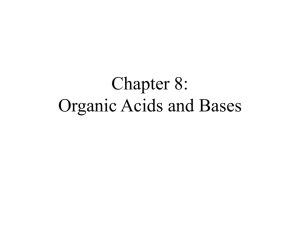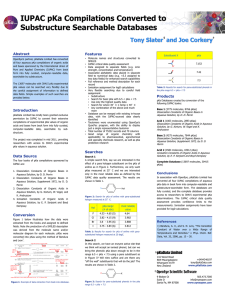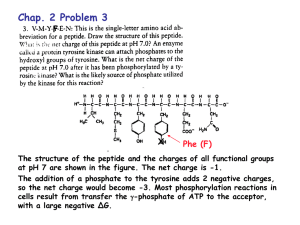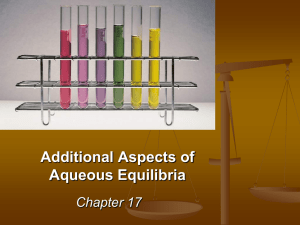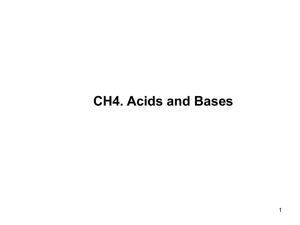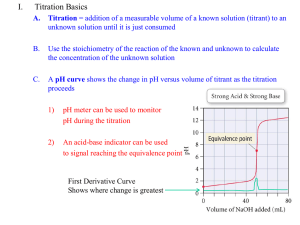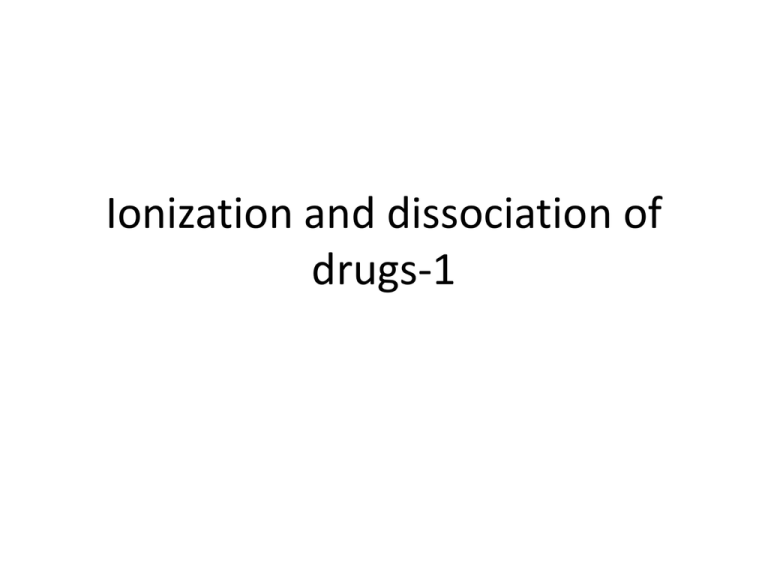
Ionization and dissociation of
drugs-1
Ionisation and dissociation
• ACIDS ARE PROTON DONORS
acid is a substance that can dissociate to give H+
and a negative ion (anion) which is called a
conjugate base:
Ionisation and dissociation
• BASES ARE PROTON ACCEPTORS
Bases can accept a proton to form the positively
charged cation ( conjugate acid of the base):
pH in different body compartments
Plasma
7.35 – 7.45
Buccal cavity 6.2 – 7.2
Stomach
1.0 – 3.0
Duodenum
4.8 – 8.2
Jejunum & ileum 7.5 – 8.0
Colon
7.0 – 7.5
O
O
Ka
H 3C
H 3C
H
OH
Ka
O
[ CH 3 COO
][ H ]
[ CH 3 COOH ]
Ka for CH3CO2H is approximately
10-5
Ka
i.e. only 1 molecule in 100,000 is DISSOCIATED (ionised).
-log10Ka = pKa
So pKa for acetic acid is 5
1
10
5
O
O
Ka
HO
S
OH
HO
S
O
H
O
O
Ka
[ HSO
4
][ H ]
[ H 2 SO 4 ]
Ka for H2SO4 is approximately 105
Ka
10
5
1
i.e. 100,000 molecules are DISSOCIATED (ionised) for every
one undissociated.
The pKa of H2SO4 is therefore -5
Ka
[ PhCH
2
NH 2 ][ H ]
[ PhCH
2
NH
3
]
Ka for PhCH2NH3+ is approximately 10-9 (pKa = 9)
Ka
i.e. only 1 molecule in 1,000,000,000 is DISSOCIATED (UNIONISED).
A weak conjugate acid does not easily donate its proton
(1 molecule in 1,000,000,000 donates a proton)
Therefore a strong base willingly accepts a proton
(1,000,000,000 molecules accept a proton for every one)
1
10
9
Ionization and dissociation of
drugs-2
pKa is a different term than pH
pH is simply a measure of the [H+] concentration in a
given solution
pH = 1 ...........the environment is acidic
pKa = 1 DOES NOT mean an acidic molecule
pH = 14 ............the environment is basic
pKa = 1 DOES NOT mean a basic molecule
You can’t tell from the pKa value whether the species in
question is acidic or basic
Weak acid
Strong base
Factors affecting the strength of acid
• The more stable conjugate base (anion) formed, the
stronger the acid will be.
• So any factor will stabilize the anion will increase the
acidity of the group, such as resonance and induction
stabilization.
• Stable negative charge results from lowering the
electron density on the atom
Cl
Cl
pKa = 0.9
Cl
C
Cl
OH
COOH
Cl
C
COO
H
Cl
O
H
Which one is the stronger acid?
pKa = 10.0
Considering Ka values relates ratio of products to reactants
Cl
Cl
C
Cl
OH
pKa = 0.9
Cl
COOH
Cl
C
COO
Ka
[ Cl 3 COO
Ka = 10-0.9
H
O
][ H ]
[ Cl 3 COOH ]
Ka
Cl
1
10
0 .9
pKa = 10.0
H
Ka
[ PhO ][ H ]
[ PhOH ]
Ka = 10-10
Ka
Phenols are weaker acids than acetates
1
10
10
Ionization and dissociation of
drugs-3
• If the atom has an available lone pair of
electrons, it can act as a base…
• The availability of these electrons will determine
the strength of the base
• As a result of that, aromatic amino group is much
weaker base than aliphatic one
tertiary amine: methyl groups compared to phenyl
group are better donating groups by induction
(more available lone pair of electrons)
the lone pair of electrons are not
available....delocalized through the phenyl group
(stable by resonance)
NH2
NH3
NH
H
NH2
pKa = 9.0
H
Which one is the stronger base?
pKa = 0.5
pKa = 0.5
Ka
[ Ph 2 NH ][ H ]
[ Ph 2 NH 2 ]
Ka = 10-0.5
NH2
NH3
NH
Ka
H
1
10
0 .5
NH2
pKa = 9.0
H
Ka
Ka = 10-9
Ka
Aromatic amines are weaker bases than aliphatic amines
[ PhCH 2 NH 2 ][ H ]
[ PhCH 2 NH 3 ]
1
10
9
• We can quantify how pH changes the ratio of
dissociated to undissociated species as follows:
pH pK
10
p H p K a
Dissociate
Undissocia
a
log
d
ted
Dissociate
10
Undissocia
d
ted
anti log pH pK
a
Dissociate
Undissocia
d
ted
Dissociate
Undissocia
d
ted
• For acidic drugs, this ratio describes the %
ionization.
• For basic drugs, this ratio describes the %
unionized form to the ionized form.
*
Effect of ionization on pharmacokinetic
and pharmacodynamic profile
What is the importance of studying the pKa values for
Acidic and basic drugs?
• only the unionised form of a drug can partition across
biological membranes (providing the unionized form is
lipophilic)
• the ionised form tends to be more water soluble
[required for drug administration and distribution in
plasma]
PARTITIONING OF ACIDS AND BASE
For acidic drugs, with a pKa of 4.0, the ionization state will be as follows
IN stomach
IN intestine
PARTITIONING OF ACIDS AND BASE
• If the pH shifts the balance towards the unionized
form, the drug would be absorbed.
• If the pH shifts the balance towards the ionized form,
the drug would not be absorbed.
• Assume the pH of the stomach is 2.0 and the pH of
the small intestine is 8.0. Where would you expect
absorption to take place from?
PARTITIONING OF ACIDS AND BASE
For basic drugs, the ionization will be as follows
IN intestine
IN stomach
Gentamicin
So we should expect that this compound will not be readily
absorbed though the lipophilic membranes although it is in the
unionized form
Practice question
• Loratadine is an orally available drug, it has a
pKa of 5, answer the followings according to
its structure:
– Is it basic, acidic or neutral compound?
– Calculate the % ionization:
• In stomach (pH = 2):
• In intestine (pH = 8):
– Based on your calculation, from where do you
think loratadine will be absorbed?
pH pK a log
Dissociate
Undissocia
Dissociate
10
Undissocia
d
ted
Unionized
Ionized
=
d
ted
Unionized
Ionized (for basic compounds)
= 10-3
% ionization = 99.9% (under stomach pH)
Under intestinal pH:
Unionized
Ionized
= 103
% ionization = 0.1%
So loratadine will be mainly in unionized form
It will be better absorbed from intestinal
membrane not from stomach
*
Effect of ionization on drug
lipophilicity
Ionization and lipophilicity
• When the drug become ionized, this will
increase its water solubility because there will
be a better solvation by ionic-dipole
interaction between ionized drug and water
molecule.
• So, once the drug get ionized it will have lower
logP than the unionized from (more polar).
Ionization and lipophilicity
• Because most drugs are ionizable at different
body pH ranges, the % ionization must be
taken into consideration when we are about
to synthesize or develop certain drug.
• Lipophilicity will determine from where the
drug will be absorbed and what target tissue
will reach.
Partition coefficient P
P = [Co ]/[Cw]
LogP = Log[Co ]/[Cw].
This equation does not determine the effect of
ionization on the lipophilicity of drugs
Partitioning of acids and base
•
Papp can be used to predict the behaviour of a compound at all pH values,
as long as we know P.
•
For acids, at pH values below the pKa, Papp = P
•
At pH values above the pKa the value of Papp decreases because the
species is ionizing and moving into the aqueous layer.
Papp
P
1 10
pH pKa
Partitioning of acids and base
• For bases, the equation becomes:
Papp
P
1 10
pKa pH
PARTITIONING OF ACIDS AND BASE
Consider drugs that are acids, for example RCOOH, which has a pKa of 4.0, and
a Partition coefficient of 200.
B iological
M em brane
G ut C ontents
RCOOH
H
+
RCOO
RCOOH
X
N o D rug
A bsorption
D rug A bsorption
Papp
P
1 10
pH pKa
•
Papp becomes 198 in the stomach suggesting that absorption will take
place
•
pH 8.0 in the small intestine, the calculated Papp suggests no absorption.
•
This equation allows to predict that an acidic drug whose unionized form
has a very low partition coefficient would not be absorbed.
Oral administration and absorption
• If a drug is to be absorbed through the mucosal
membranes that line the gut, then it must be in its
lipophilic unionised form to partition out of the aqueous
medium.
• The partition co-efficient of the unionised form will also
determine how much is absorbed.
• The absorption phase of the dose-response curve is
therefore heavily influenced by the pKa and log P of a
drug.
Oral administration and absorption
Orally administered drugs must have:
•
•
•
•
logP < 5.
No more than 10 hydrogen bond acceptors.
No more than 5 hydrogen bond donors.
A molecular weight less than 500 Dalton.
These points are called ‘’ Lipinski’s rule of five’’
• Not more than 7 rotatable bonds.
Applications of drug ionization
Remember the followings
For acids:
1. a high pka means the species is predominantly
unionised, is a bad proton donor, and a weak acid
2. a low pka means the species is predominantly
ionised, is a good proton donor, and a strong acid
pH < pKa by 2 units, 99% unionised
pH > pKa by 2 units, 99% ionised
For bases:
1. a high pka means the species is predominantly ionised, is a
good proton acceptor, and a strong base
2. a low pka means the species is predominantly
unionised, is a bad proton acceptor, and a weak base
pH < pKa by 2 units, 99% ionised
pH > pKa by 2 units, 99% unionised
Common acidic functional groups in
pharmaceutical chemistry and their pKa values
O
R
4-5
OH
10
OH
9.9
O
R
NH
8-10
R
O
<2
Examples of acidic drugs
Common basic functional groups in
pharmaceutical chemistry and their pKa values
R
10.0
NH2
4.6
NH2
R
NH
R
10.6-11.0
HN
N
6.5
R
N
R
R
9.8-10.8
N
5.2
Examples of basic drugs
Common neutral functional groups in
pharmaceutical chemistry
R
R
O
NH2
R
R
O
O
R
O
NH
O
R
O
R
HN
N
R
R
R
OH
N
H
R
Molecular properties and routes of administration
•
•
•
•
•
•
•
Oral
rectal
vaginal
topical
parenteral
Respiratory
The molecular properties of the drug must be determined before any
route can be considered, but other factors are important
Factors to consider when choosing
a route of administration
•
•
•
•
•
•
•
molecular properties of the drug
physiological nature of the route
patient compliance
onset of action
the condition being treated
systemic or local effect (side effects)
metabolism




